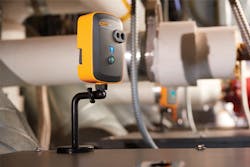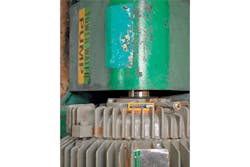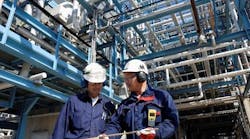Asset monitoring for process control and operation has given rise to the Industrial Internet of Things (IIoT). With all the data provided by this cloud-based technology, little to none has been leveraged for maintenance activities until recently. Connected reliability is becoming a reality, and cost-effective, wireless, remote sensors guarantee the promise of the IIoT.
Adoption barriers
Although the IIoT could help most maintenance and reliability teams work more efficiently and increase uptime, overall asset health and reliability, teams are often unable to take advantage of it.
Reliability, maintenance and repair have not benefited as much from the collection and usage of cloud-based data, and most day-to-day activities remain manual and often reactive, especially on equipment that is not as critical to operations. Many factors limit IIoT adoption. These include:
• Many maintenance and reliability teams rely on scheduled and route-based maintenance; the time involved to move from reactive and preventive to predictive and condition monitoring strategies and, more broadly, reactive activities can appear insurmountable
• The historically high cost of condition monitoring hardware and software
• Limited access and flexibility of information technology (IT), including cybersecurity concerns
• Disparate data streams and/or historical data in silos with no connectivity
• Culture change, including training and buy-in to new tactics
Technology solutions
Facilities need a framework for connecting assets, systems and people — turning data into insights to drive better outcomes. This has led to the idea of connected reliability, which gives teams a roadmap for moving past incremental gains to make a quantum leap to an ideal setup.
Figure 3. Thermal imaging sensors can monitor difficult-to-access equipment or large areas quickly.
Thermal imaging sensors
Thermal imaging sensors are versatile and provide many benefits. They are safe to use and contact with equipment is not required to gather data. For proactive maintenance, they can quickly reveal the invisible problems within equipment. To leverage IIoT for condition monitoring and reliability, infrared technology is one of the easiest to use within the digital tool belt.
The areas in which thermal imaging can be used are virtually endless. It is safer for personnel and processes because it is noninvasive and requires no downtime to install.
With the wide measurement range, it can monitor difficult-to-access equipment or large areas quickly. Using condition monitoring software with the sensor, valuable data can be saved and trended in the cloud. Because of its ease of installation and flexibility, end users see quick returns on their investments.
Vibration sensors
Vibration monitoring allows teams to triage asset health, further analyze and diagnose the identified asset and perform the right corrective action at the right time. Installing vibration sensors that use IIoT condition monitoring software on equipment allows technicians to spend less time taking manual readings and walking routes and more time addressing problems.
The top five benefits of vibration screening and cloud-based condition monitoring software are:
- Screen quickly, act quickly.
- Organize information for data-driven decisions.
- Receive alarms for abnormalities.
- Identify the four most common faults (imbalance, misalignment, bearing wear and looseness) early.
- Reduce maintenance spend.
Figure 2. Vibration monitoring allows teams to triage the health of assets.
Power monitors
Remote, three-phase power monitors measure key electrical parameters of three-phase equipment and stream data to the cloud. Monitoring electrical parameters like current and harmonic distortion can reveal how the machinery (or equipment) is performing, for example:
• A baseline current or load at a critical pump is trending dangerously close to the motor’s maximum current rating, taking service factor into account.
• The total power at an induction furnace appears to fluctuate abnormally.
• Determining how often a submersible or hydraulic pump is cycling on/off to maintain flow or pressures, in some cases validates that power is supplied to the pump or other equipment.
These monitors can measure:
• Single or three-phase loads
• Voltage, current and frequency
• Power including active power, nonactive power and power factor
• Total harmonic distortion
B3 Electric builds reputation with power monitoring
B3 Electric serves primarily industrial customers in automotive-based manufacturing. The company conducts electrical troubleshooting for customers who require a meter.
B3 President John Baker used inexpensive, single-phase remote meters that monitored two legs of the power stool but not with great accuracy. In mid-2017, he wanted a better way to monitor power. He began using a cloud-based, three-phase power monitor with IIoT condition monitoring software, which captured voltage, current, power factor and frequency issues.
"We could get remote notifications, develop reports, export data, make graphs and trend improvements as we made changes on-site," Baker reported.
Flexibility and performance
With the cloud-connected, three-phase power monitor, Baker set up the under- and overvoltage or current parameters. If the asset operates outside the predetermined parameters, he receives push notifications via the condition monitoring software app on his phone.
The two meters are used in different ways:
- For example, a customer may try to improve efficiency with a 25-horsepower motor on a piece of equipment. He connects one power monitor on the circuit that feeds the motor and one on the whole building. "We could see that it’s getting a large current spike from the motor starting, identify how it affects the rest of the system and make recommendations," explained Baker. "After we install the new equipment, we can monitor it again to show the improvements that we’ve made."
- B3 installed a 1,600-amp uninterruptible power supply (UPS) system at the state data center in 2017. Baker connected a power monitor and watched the voltage. The current stepped down during equipment shutdown. As he brought the new equipment online, he watched to see that the new UPS was consistent and maintained the voltage.
- Baker uses the power factor and frequency measures on the monitors and reviews the data depending on the application. He found that the monitors are good for quality control as well as identifying issues and fixing them.
Reduced troubleshooting time
Baker and his employees now work more efficiently with their power monitors and cloud-based condition monitoring software. With other data collectors, the meter may need to be on-site for a few days, then employees would need to go back to gather the data.
"The disadvantage there is that no one can recall a week later what was going on Wednesday at 2 p.m. when a big current spike was recorded," said Baker. "Having the information right now is extremely valuable. [The condition monitoring software] saves us a ton of time and cuts down on the number of on-site trips."
Enhanced safety
Remote monitoring also increases worker safety. "It’s dangerous any time you’re working around electricity," said Baker. "You really have to be careful. Having the remote monitoring capacity gives you the ability to put the power monitor in a dangerous area, but you don’t have to physically be there in arc flash gear," he continued. "You just slip a [monitor] in there and watch it from somewhere else."
Customer power savings
If B3 wants to conduct an energy savings project for a client, Baker can use the power monitor to monitor and log power factor for energy savings proposals.
New revenue and better service
Baker now offers revenue-generating diagnostic services that he could not before. "It opens up whole avenues of services that we can offer," he said. "We move the monitors around a lot — they don’t stay on one system more than a week at a time — and we bill that as a separate service."
"The [power monitor] takes all the guesswork out and the replace-parts-and-hope-that-fixes-it mentality," he added. "Because you’re actually finding an issue and identifying [the source]."
Baker can monitor the environment, provide data trends, even add members of the factory’s maintenance team so that they receive the push notifications. It all helps build his business.





